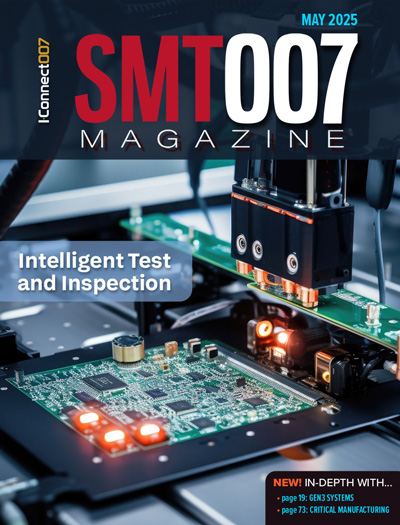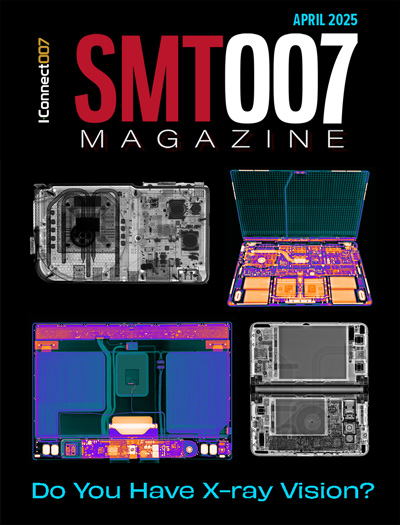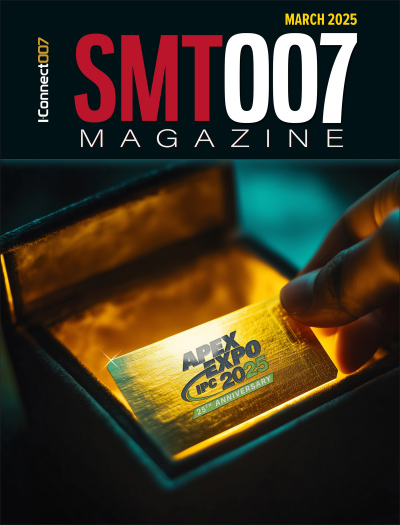-

-
News
News Highlights
- Books
Featured Books
- smt007 Magazine
Latest Issues
Current Issue
Intelligent Test and Inspection
Are you ready to explore the cutting-edge advancements shaping the electronics manufacturing industry? The May 2025 issue of SMT007 Magazine is packed with insights, innovations, and expert perspectives that you won’t want to miss.

Do You Have X-ray Vision?
Has X-ray’s time finally come in electronics manufacturing? Join us in this issue of SMT007 Magazine, where we answer this question and others to bring more efficiency to your bottom line.

IPC APEX EXPO 2025: A Preview
It’s that time again. If you’re going to Anaheim for IPC APEX EXPO 2025, we’ll see you there. In the meantime, consider this issue of SMT007 Magazine to be your golden ticket to planning the show.
- Articles
- Columns
Search Console
- Links
- Media kit
||| MENU - smt007 Magazine
China Retains Market Advantage in Battery Development Despite US Raising Tariffs on Chinese Battery Imports to 25%
May 23, 2024 | TrendForceEstimated reading time: 1 minute
On May 14, the White House announced significant tariff increases on Chinese EVs and batteries. EV tariffs will jump from 25% to 100%, and battery tariffs will rise from 7.5% to 25%. TrendForce posits that Chinese EVs account for less than 2% of the US EV market, making the actual impact of these tariff hikes minimal. However, the increased battery tariffs are expected to raise EV production costs for US automakers. This could complicate efforts to reduce overall vehicle costs and incentivize consumer purchases.
TrendForce research indicates that Chinese LFP batteries already have a price advantage; the cost of Chinese batteries remains lower than US-manufactured ones—which are more than double in price—even with increased tariffs. Additionally, a recent temporary exemption in the IRA regarding critical minerals from a foreign entity of concern (FEOC) for battery production highlights the US’s continued reliance on Chinese batteries. US automakers still require more time to transition away from Chinese suppliers.
In the short term, increased tariffs and IRA regulations underscore the growing geopolitical influence on the EV industry. US automakers can mitigate these impacts by partnering with established battery makers from Japan and South Korea or investing in solid-state battery technology. In the long term, scaling up EV sales to achieve economies of scale is crucial for reducing battery costs. Traditional US automakers must decide between focusing on fuel vehicles or EVs to avoid resource misallocation. One pertinent example is BYD, which ceased production of fuel vehicles and, within two years, surpassed Tesla in annual sales (combining pure electric and plug-in hybrid vehicles) to become the world’s largest EV producer.
Moreover, the ability to produce LFP batteries domestically is critical for the US. While most US EVs currently use NCM batteries, market reports suggest Tesla has established an LFP battery production line in its Sparks, Nevada factory, with an estimated capacity of 10 GWh—sufficient for approximately 130,000 vehicles with 75 kWh batteries.
LG Energy Solution (LGES) is also setting up an LFP production line in Arizona, which is slated for mass production by 2026. Other companies, including Gotion, American Battery Factory Inc., FREYR Battery, and Our Next Energy, have plans to establish LFP production lines. However, LFP batteries are expected to be primarily used in ESS rather than exclusively in the EV sector.
Suggested Items
MVTec Presents Advantages of Machine Vision for Battery Production
05/16/2025 | MVTecMVTec Software GmbH, a leading international manufacturer of machine vision software, will once again demonstrate the added value of machine vision for battery production at this year's Battery Show Europe in Stuttgart.
CEE PCB to Exhibit at The Battery Show Europe 2025
05/14/2025 | CEE PCBTom Yang, CEO of CEE PCB, has announced that the company will exhibit at The Battery Show 2025, held from June 3-5 at the Messe Stuttgart in Stuttgart, Germany, in Booth F69 in Hall 7.
Forge Nano Secures $40M to Scale U.S. Battery Manufacturing and Commercial Semiconductor Equipment Businesses
05/02/2025 | Forge NanoForge Nano, Inc., a technology company pioneering domestic battery and semiconductor innovations, announced the successful close of $40 million in new funding.
QuantumScape, Murata Announce Framework for Ceramics Collaboration
04/25/2025 | BUSINESS WIREQuantumScape Corporation, a global leader in next-generation solid-state lithium-metal battery technology, and Murata Manufacturing Co. have entered into the first phase of an agreement to explore a collaboration for high-volume manufacturing of ceramic film for QS’s solid-state battery technology.
Murata, QuantumScape Start to Explore a Collaboration for Manufacturing of Ceramics
04/24/2025 | MurataMurata Manufacturing Co., Ltd. and QuantumScape Corporation have entered into the first phase of an agreement to explore a collaboration for high-volume manufacturing of ceramic film for QuantumScape’s solid-state battery technology.


